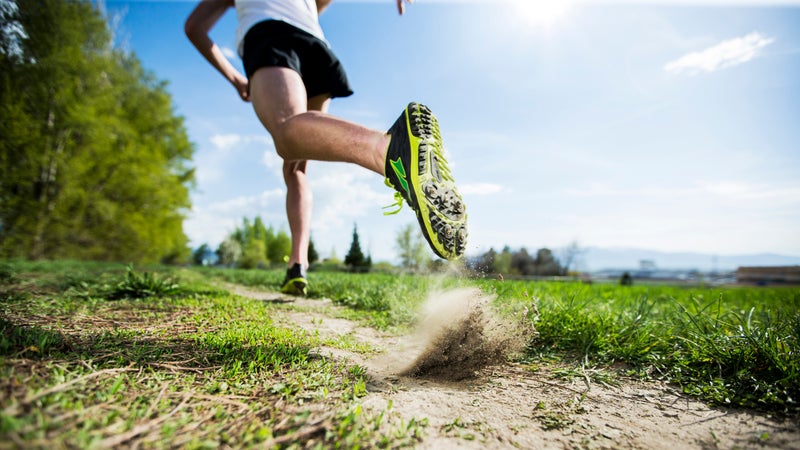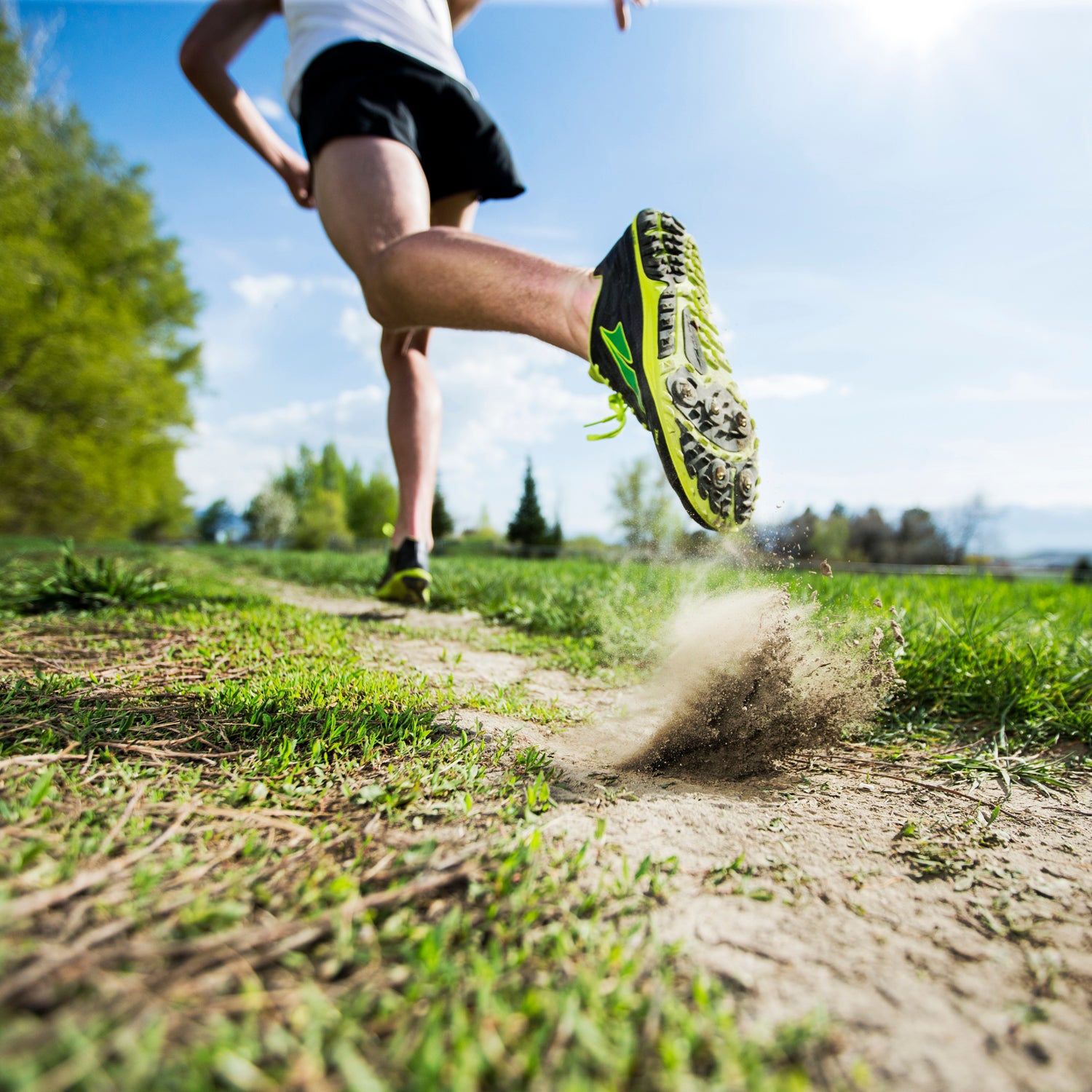The last place you’d expect to see the bold logo of Hoka One One, a brand known for its max-cushioned midsoles, is on a pair of track spikes. But the company put in two years of research and development to create a distance spike called the Hoka Speed EVO R that debuted at the U.S. Trials last July and went on sale for the rest of us this month.
“If you want to be a true running company, you have to look at the whole spectrum of running, from track to ultras,” says Jean-Luc Diard, co-founder of Hoka. “We call it T4: track, tarmac, triathlon, and trail.”
As might be expected from a company that established its reputation making unconventional shoes, the Hoka Speed EVO R spike is different from other spikes on the market. To start, the left shoe doesn’t match the right. Both soles are tuned to provide the strongest support when you’re turning left—which, on the track, you do about 60 percent of the time. The spike location is different for each foot, and the semirigid torsion plate, covered with sharp teeth, angles from the left side of the arch to the right side of the heel on both shoes, providing stability as you torque your way around the circuit.
The Speed EVO R also provides more cushioning than you’re used to seeing in a spike, but not quite as much as it would seem from just looking at the shoe. Your foot doesn’t sit on top of the full midsole height: some of that thickness is a sculpted sidewall that provides what Diard calls a “bucket seat,” centering the foot and creating arch support. The midsole foam is typical Hoka light but more responsive than the stuff found in the company’s training shoes.
“We put twice as much cushioning as in most spikes,” Diard says. “On long distances, even the best runners start to heel strike. When you have nothing to provide protection, it hurts big-time.” He says most runners will compromise their stride in response to this pain, and thus won’t arrive at the final laps—where the real racing occurs—in prime condition.
The distinctive rocker shape, with the ball curving up to the toe, is a Hoka trademark designed to reduce stress on your calf muscle and foot tendons. While a flatter plate might provide a longer, more powerful lever, the rocker puts less strain on your Achilles tendon and keeps all your energy rolling forward rather than driving upward.
That rocker and the extra cushioning are rather unique in spikes, says Martyn Shorten, head of the BioMechanica research lab in Portland, Oregon, who studies how runners interact with shoes and has examined prototypes of the spikes. Shorten’s research has identified that 90 percent of runners heel strike, even many who think they don’t. While he says elite track athletes are more likely to land on the forefoot, 75 percent or more are probably landing on their heels in a distance race and can use the extra padding. As for the rocker, Shorten says it limits the metatarsal motion—bending and rebounding of the toes—but compensates by allowing a great range of ankle movement, thus allowing the foot to push back with less Achilles stress. Neither element would be welcome in a sprint spike, where power is key, but, Shorten says, “Sprinting and distance running have a completely different physiological effect. Distance running is more about energy management.”
Energy management is indeed what Hoka had in mind in the design of its spike. “Winning is first and foremost about not losing,” Diard says. “The goal is providing people the ability to train with the least possible risk of injury. And then, through the race, making it as easy as possible during the tactical phase so they can be ready for the final thing.”
To find out how well the spikes met this goal, the company had fatigued athletes test the product after a three-to-four-hour training session. Leo Manzano, the 1,500-meter silver medalist at the London Games who finished fourth in last summer’s trials, has been wearing the shoes for more than a year. He says that in the past, he’d run only a quarter of a workout in his spikes. With the EVO R, Manzano has been running half or sometimes all of a workout with the spikes on, making the training more specific to his racing.
While competition spikes on athletes like Manzano provide a high profile for companies, industry experts don’t see this trend taking off across the market. “Hoka is doing amazing things, trying to cover every single aspect there is,” says Lee Troop, a former elite athlete and coach who now owns Fleet Feet Sports in Boulder. “There are going to be people who want [the new spikes], but primarily, those that need extra padding and cushion will wear flats (road racing shoes)…I don’t think there is going to be a mass need.” That said, Troop and many others never saw the Hoka-inspired oversized trend in running shoes taking off like it did. “It will be interesting to see how [the release of the spikes] will unfold,” he says.

Hoka isn’t the only distance-running company venturing onto the track. Altra, known for its zero-drop, foot-shaped, well-cushioned shoes commonly seen at ultras, has also released a pair of (relatively) comfortable spikes. “Virtually all spikes on the market are human torture devices,” says Golden Harper, co-founder of Altra. “They have placed a premium on looking narrow and ‘fast,’ rather than on actually performing. It just makes sense to have shoes that are actually comfortable and allow the foot to assume its natural position, rather than squeezing the toes and the foot like a vise grip.”
Besides its distinctive shape, which provides room for toes to splay, the Altra Golden Spike has 15 millimeters of cushioning between the wearer and the ground along the entire length of the shoe. Five spikes screw into a sole so flexible that it can’t really be called a plate. The ride feels much like a lighter version of Altra’s popular original model, the Instinct, only with more traction.
As with the Hokas, it’s unclear whether these shoes will find a solid audience. Runners who have tested them report they don’t have the pop one expects from a track spike, but they are significantly more comfortable and seem applicable for cross-country and the longest track events.
If you’re interested in testing the shoes for yourself, the Altra Golden Spike retails for $90. The Hoka Speed EVO R sells for $130.

